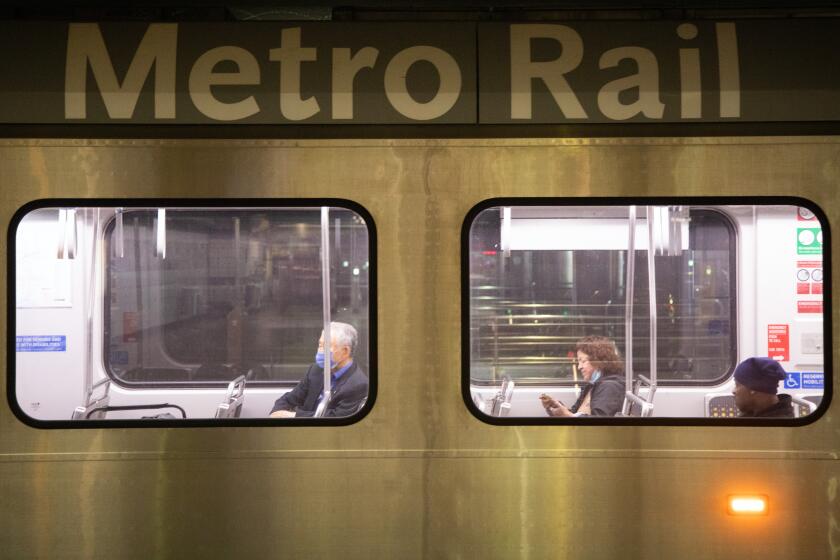Local Drivers Pay Price for Living Outside L.A.
- Share via
Ventura County residents spend thousands of dollars more each year on driving costs to live outside Los Angeles, a factor that may partly offset lower housing costs found in far-flung suburbs, according to a new study released Thursday.
The survey comparing travel costs in various cities found that residents who live near shopping, jobs and good public transportation spent from $2,000 to $4,000 under the average for the region.
Factors cited by the study for lower transportation costs include shorter commuting distances, proximity to shopping and the availability of public transit alternatives, such as buses and trains.
The study, for instance, showed some areas of Los Angeles average less than one car per household, indicating that large numbers of people in those areas are transit-dependent, while some communities in Ventura and San Bernardino counties average nearly five cars per household.
Researchers for the Washington-based Surface Transportation Policy Project and Chicago’s Center for Neighborhood Technology put together the study.
The researchers are advocates for growth and environmental policies aimed at reducing urban sprawl. They draw their statistics from a variety of conventional federal and regional data collection agencies.
“The amount of money we spend on transportation has been increasing dramatically,” said Gloria Ohland of the nonprofit group’s Los Angeles office. “People constantly talk about the cost of housing, comparing prices from one community to another. We are doing that with cars.”
Ohland’s organization is a chief supporter of a federal program offering mortgage breaks to home buyers who can show they will save significantly on transportation costs if they buy a house near public transportation or their jobs.
Called “location efficient mortgages,” the financial instruments have had limited success in the Los Angeles area.
Ventura County’s 10 cities, from Thousand Oaks to Ojai, ranked in the bottom two-third among Southern California cities for money saved on transportation costs, based on research released with the study.
Within the county, Santa Paula and Ventura residents spend about half as much getting around than those in more commuter-oriented cities such as Camarillo and Ojai, according to the study.
Living along the Ventura Freeway in neighborhoods such as in Camarillo cost about $8,155 more in driving expenses than living in downtown Ventura, the study found.
*
Bill Fulton, president of Ventura-based Solimar Research Group, which studies metropolitan growth, said he believes Ventura County’s rankings reflect three factors: the compactness of cities, how close homes are to jobs and shopping, and a city’s overall wealth.
He said it’s not surprising poorer communities such as Santa Paula, Oxnard and Ventura show more transportation cost savings than affluent communities such as Simi Valley and Thousand Oaks, where families have at least two cars and are able to drive as much as they please.
“The rankings reward poverty in a sense, because poor people can’t afford cars and they take the bus,” Fulton said.
Fulton explained Camarillo and Ojai’s high driving costs by saying these cities are true suburbs--affluent communities far from jobs. Although Thousand Oaks and Simi Valley are wealthy, they are much closer to jobs in the San Fernando Valley and the Los Angeles Basin, he said.
The study found that in the Los Angeles-Riverside-Orange County area, annual auto costs per household were lowest in Los Angeles, Santa Monica, West Hollywood, Long Beach, Glendale and Pasadena, where households spent from $3,200 to $5,000 a year on car travel.
According to the study, some households in the Antelope Valley spent the most on transportation costs, from $7,600 to $12,300 a year.
Households in Newhall, Irvine in Orange County, and San Bernardino were also on the high end, spending from $7,400 to $10,000 annually on driving costs.
*
City officials accepted some of the study’s findings, but challenged the notion that increased driving costs offset the significantly lower housing costs in distant suburbs.
“We are probably the most affordable area in Southern California and people are willing to make the commute to live here,” said San Bernardino spokeswoman June Durr. She cited a survey showing the average cost of a three-bedroom home in San Bernardino was $90,000.
Durr said a major goal of the city administration is to spur business expansion so more city residents can find high-paying jobs at home, and avoid higher commuting costs.
In Palmdale, City Manager Bob Toone conceded the wide open spaces of the Antelope Valley contributed to extra transportation costs.
While higher transportation costs might offset some of the savings on home purchases, he said, it was hardly enough to deter buyers.
“The average house up here is selling for $120,000. What is it in Los Angeles? $350,000? You have to buy a lot of gas to make up for that difference,” Toone said.
The annual household expenditures on transportation were calculated by combining research data on the cost of vehicle purchases, car-related expenses, such as insurance and repairs, and money spent on public transportation.
In Southern California, the study found spending on transportation ranked second on a typical family’s budget, ranking behind only housing and ahead of food.
*
Fulton said he believes it will always be more difficult to reduce the cost of auto transportation in Southern California than in other parts of the state and country until the region gets a decent public transportation system.
“The thing that dramatically reduces the cost of driving is when you eliminate the need for a second car,” he said. “In Southern California we have such a poor transit system generally, that it’s almost impossible for a family to do that.”
Nationally, the three-county Los Angeles metropolitan area ranked 15th in percent of expenditures spent on transportation, with households shelling out an average of $7,224 in 1997 and 1998, the study says.
The national survey found drivers in the Houston-Galveston-Brazoria region in Texas spent the most during the two-year period, $8,840, followed by Atlanta, $8,513, and Dallas-Fort Worth, $8,717.
*
Shuitt is a Times staff writer and Ragland is a correspondent.
(BEGIN TEXT OF INFOBOX / INFOGRAPHIC)
Travel Cost Comparisons
*--*
Annual auto cost Average vehicles Annual miles City per household per household driven Camarillo $10,052 3.80 50,015 Port Hueneme $5,752 1.95 22,310 Moorpark (near 118 $6,880 2.44 28,855 & 23) Ojai $6,615 2.35 26,352 Downtown Oxnard $5,606 1.88 21,569 Thousand Oaks $5,791 1.98 22,270 Downtown Ventura $5,431 1.85 19,569
*--*
Source: Surface Transportation Policy Project
More to Read
Sign up for Essential California
The most important California stories and recommendations in your inbox every morning.
You may occasionally receive promotional content from the Los Angeles Times.













